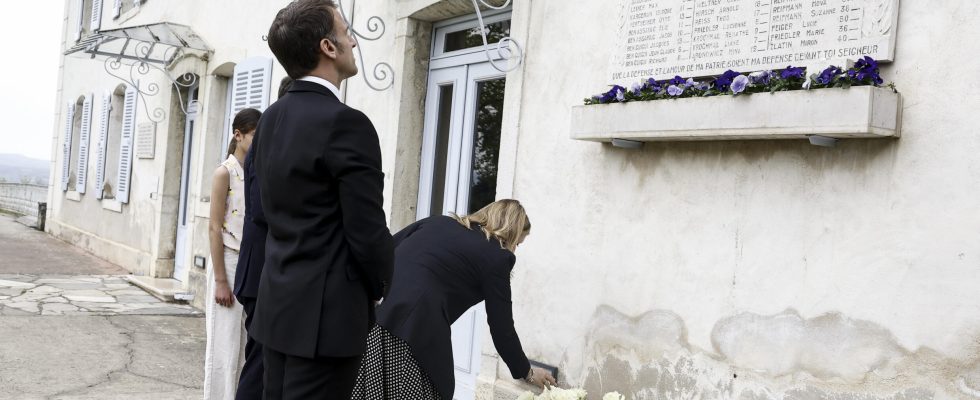The French president paid tribute this Sunday to the resistance fighters who gathered on the Glières plateau, in the Alps, from January to March 1944 to receive airdrops of weapons. He then went to Maison d’Izieu, in Ain, where 44 Jewish children were rounded up. This day marks the start of a commemorative itinerary, retracing the battles of the Liberation in 1944 and the end of the Occupation, which will culminate in June with the 80th anniversary of the landing in Normandy.
At the end of the morning, the French head of state greeted the 105 “ martyrs » des Glières, buried at the national necropolis of Morette, in Thônes in Haute-Savoie, “heroes” who defended “ 9,000 hectares of free France in the hollow of the peaks “.
In front of three sections of Alpine hunters and nearly 600 children, and accompanied by the President of the National Assembly Yaël Braun-Pivet and the French Minister of the Armed Forces Sébastien Lecornu, Emmanuel Macron invoked the motto of these resistance fighters. ” “Live Free or Die” : this is our viaticum, yesterday, today and tomorrow, so that the Republic may live and France may live “, he said, making the connection, a little later, during a crowd, with the Russian invasion of Ukraine: ” The attackers must stop […] that they are sure of our determination, so that we can “Live Free or Die” “.
Emmanuel Macron paid tribute to the diversity of the 465 resistance fighters who gathered in 1944 on this plateau at an altitude of 1,400 meters to receive airdrops of weapons from the Allies, in the run-up to the Provence Landings of August 1944. Professors, peasants, notables, Jews and Catholics, communists, socialists or Gaullists, anarchists, French and foreign officers united in the same fight against Nazism », he detailed, saluting the memory of Jean Isaac Tresca, last Glières resistance fighter, who died in 2022 at the age of 104.
“French tragedy”
At the end of March 1944, the German army and militia invaded the plateau. Two thirds of the guerrillas were taken prisoner and 124 killed during the fighting or shot, nine disappeared, sixteen died in deportation. “ This is indeed our French tragedy: that there were not the French on one side and the Nazis on the other. […] French people imprisoned French people, French people murdered French people », recalled the head of state.
Emmanuel Macron had already made the trip to Glières in the company of ex-president Nicolas Sarkozy, on March 31, 2019, for the 75th anniversary of the fighting.
Tribute to rounded up Jewish children
This Sunday afternoon, the French president placed a white rose in front of the entrance to the Maison d’Izieu in the Ain department, before speaking with four former members of this refuge. “ It takes a lot of resilience to come and talk to you », noted Roger Wolman who, in 1943, aged five, spent a few weeks in the house when his parents had been deported.
Between May 1943 and April 1944, the colony, founded by Sabine Zlatin, a Jewish resistance fighter of Polish origin, and her husband Miron Zlatin, who had fled the Russian revolution, took in around a hundred children. On April 6, 1944, 44 Jewish children aged four to twelve were rounded up by the Lyon Gestapo on orders to Klaus Barbie, with their seven educators, also Jews. All were deported to the camps of Auschwitz-Birkenau in Poland and Reval in Estonia. Only one educator survived.
Questioned during a new crowd bath on the rise of extremes, Emmanuel Macron noted that “ nothing justifies[ait] to return to these deadly ideologies [..] We must not give in on our values and educate. »
The “Renaissance” of France
This long memory cycle, which marks the beginning of the “ Renaissance » of France, according to the formula established by the Élysée, with the victory over the Nazi occupiers and the Vichy regime in 1944, will continue until the end of the year.
It will culminate on the occasion of the 80th anniversary of the Normandy landings, commemorated with great fanfare for three days. The American President, Joe Biden, is also expected in France on June 6.
On April 16, Emmanuel Macron will honor the Vercors resistance fighters before commemorating the Liberations of Marseille in May, Paris in August and Strasbourg in November.
Ceremonies will also be held for the commemorations of the Landing of Provence in August. And a tribute will be paid to the former minister and resistance fighter Georges Mandel, assassinated in 1944.
Since 2017, Emmanuel Macron has been making national tributes and historical references, more than his predecessors, with the exception, perhaps, of General de Gaulle. A way for him to invoke a Nation brought together in times of fractures, and to outline, implicitly, his own political project.
Interweaving of memorial and electoral agendas
Emmanuel Macron is due to speak on June 6, three days before the European elections in France. He should, according to his entourage, focus his speech on the return of war to Europe and the rise of populism on the Old Continent.
After “ memory roaming » around the First World War in 2018, the commemorations of the Liberation must constitute a highlight of Emmanuel Macron’s second five-year term, with the Paris Olympic Games.
